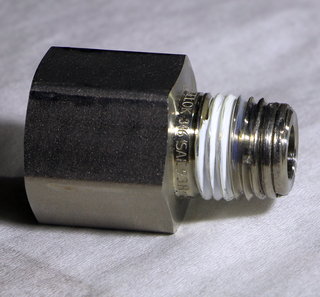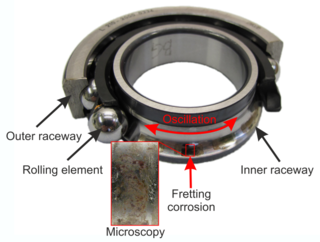Related Research Articles
A lubricant is a substance, usually organic, introduced to reduce friction between surfaces in mutual contact, which ultimately reduces the heat generated when the surfaces move. It may also have the function of transmitting forces, transporting foreign particles, or heating or cooling the surfaces. The property of reducing friction is known as lubricity.

Sintering or frittage is the process of compacting and forming a solid mass of material by heat or pressure without melting it to the point of liquefaction.

Corrosion is a natural process that converts a refined metal into a more chemically-stable form such as oxide, hydroxide, or sulfide. It is the gradual destruction of materials by chemical and/or electrochemical reaction with their environment. Corrosion engineering is the field dedicated to controlling and preventing corrosion.

Wear is the damaging, gradual removal or deformation of material at solid surfaces. Causes of wear can be mechanical or chemical. The study of wear and related processes is referred to as tribology.
Tribology is the science and engineering of interacting surfaces in relative motion. It includes the study and application of the principles of friction, lubrication and wear. Tribology is highly interdisciplinary. It draws on many academic fields, including physics, chemistry, materials science, mathematics, biology and engineering. People who work in the field of tribology are referred to as tribologists.

Powder metallurgy (PM) is a term covering a wide range of ways in which materials or components are made from metal powders. PM processes can avoid, or greatly reduce, the need to use metal removal processes, thereby drastically reducing yield losses in manufacture and often resulting in lower costs.

Dental porcelain is a dental material used by dental technicians to create biocompatible lifelike dental restorations, such as crowns, bridges, and veneers. Evidence suggests they are an effective material as they are biocompatible, aesthetic, insoluble and have a hardness of 7 on the Mohs scale. For certain dental prostheses, such as three-unit molars porcelain fused to metal or in complete porcelain group, zirconia-based restorations are recommended.

Galling is a form of wear caused by adhesion between sliding surfaces. When a material galls, some of it is pulled with the contacting surface, especially if there is a large amount of force compressing the surfaces together. Galling is caused by a combination of friction and adhesion between the surfaces, followed by slipping and tearing of crystal structure beneath the surface. This will generally leave some material stuck or even friction welded to the adjacent surface, whereas the galled material may appear gouged with balled-up or torn lumps of material stuck to its surface.
A coating is a covering that is applied to the surface of an object, usually referred to as the substrate. The purpose of applying the coating may be decorative, functional, or both. The coating itself may be an all-over coating, completely covering the substrate, or it may only cover parts of the substrate. An example of all of these types of coating is a product label on many drinks bottles- one side has an all-over functional coating and the other side has one or more decorative coatings in an appropriate pattern to form the words and images.

A superalloy, or high-performance alloy, is an alloy with the ability to operate at a high fraction of its melting point. Several key characteristics of a superalloy are excellent mechanical strength, resistance to thermal creep deformation, good surface stability, and resistance to corrosion or oxidation.

Bioglass 45S5 or calcium sodium phosphosilicate, commonly referred to by its commercial name Bioglass and NovaMin, is a glass specifically composed of 45 wt% SiO2, 24.5 wt% CaO, 24.5 wt% Na2O, and 6.0 wt% P2O5. Glasses are non-crystalline amorphous solids that are commonly composed of silica-based materials with other minor additives. Compared to soda-lime glass (commonly used, as in windows or bottles), Bioglass 45S5 contains less silica and higher amounts of calcium and phosphorus. The 45S5 name signifies glass with 45 weight % of SiO2 and 5:1 molar ratio of calcium to phosphorus. This high ratio of calcium to phosphorus promotes formation of apatite crystals; calcium and silica ions can act as crystallization nuclei. Lower Ca:P ratios do not bond to bone. Bioglass 45S5's specific composition is optimal in biomedical applications because of its similar composition to that of hydroxyapatite, the mineral component of bone. This similarity provides Bioglass' ability to be integrated with living bone.

Fretting refers to wear and sometimes corrosion damage at the asperities of contact surfaces. This damage is induced under load and in the presence of repeated relative surface motion, as induced for example by vibration. The ASM Handbook on Fatigue and Fracture defines fretting as: "A special wear process that occurs at the contact area between two materials under load and subject to minute relative motion by vibration or some other force." Fretting tangibly degrades the surface layer quality producing increased surface roughness and micropits, which reduces the fatigue strength of the components.

Ceramic glaze is an impervious layer or coating of a vitreous substance which has been fused to a ceramic body through firing. Glaze can serve to color, decorate or waterproof an item. Glazing renders earthenware vessels suitable for holding liquids, sealing the inherent porosity of unglazed biscuit earthenware. It also gives a tougher surface. Glaze is also used on stoneware and porcelain. In addition to their functionality, glazes can form a variety of surface finishes, including degrees of glossy or matte finish and color. Glazes may also enhance the underlying design or texture either unmodified or inscribed, carved or painted.

Thermal barrier coatings (TBCs) are advanced materials systems usually applied to metallic surfaces operating at elevated temperatures, such as gas turbine or aero-engine parts, as a form of exhaust heat management. These 100 μm to 2 mm thick coatings of thermally insulating materials serve to insulate components from large and prolonged heat loads and can sustain an appreciable temperature difference between the load-bearing alloys and the coating surface. In doing so, these coatings can allow for higher operating temperatures while limiting the thermal exposure of structural components, extending part life by reducing oxidation and thermal fatigue. In conjunction with active film cooling, TBCs permit working fluid temperatures higher than the melting point of the metal airfoil in some turbine applications. Due to increasing demand for more efficient engines running at higher temperatures with better durability/lifetime and thinner coatings to reduce parasitic mass for rotating/moving components, there is significant motivation to develop new and advanced TBCs. The material requirements of TBCs are similar to those of heat shields, although in the latter application emissivity tends to be of greater importance.
Dry lubricants or solid lubricants are materials that, despite being in the solid phase, are able to reduce friction between two surfaces sliding against each other without the need for a liquid oil medium.
Chameleon coating, also known as nano composite tribological coating, is an adaptive adhesive that uses nanotechnology to adjust to environmental fluctuations to make living conditions more suitable to the object that the coat has been applied to.
Tribocorrosion is a material degradation process due to the combined effect of corrosion and wear. The name tribocorrosion expresses the underlying disciplines of tribology and corrosion. Tribology is concerned with the study of friction, lubrication and wear and corrosion is concerned with the chemical and electrochemical interactions between a material, normally a metal, and its environment. As a field of research tribocorrosion is relatively new, but tribocorrosion phenomena have been around ever since machines and installations are being used.

Ceramic matrix composites (CMCs) are a subgroup of composite materials as well as a subgroup of ceramics. They consist of ceramic fibres embedded in a ceramic matrix. The matrix and fibres can consist of any ceramic material, whereby carbon and carbon fibres can also be considered a ceramic material.
Tribofilms are films that form on tribologically stressed surfaces. Tribofilms are mostly solid surface films that result from a chemical reaction of lubricant components or tribological surfaces.
Open System Tribology is a field of tribology that studies tribological systems that are exposed to and affected by the natural environment.
References
- I.A. Inman. Compacted Oxide Layer Formation under Conditions of Limited Debris Retention at the Wear Interface during High Temperature Sliding Wear of Superalloys, Ph.D. Thesis (2003), Northumbria University, ISBN 1-58112-321-3 (preview)
- S.R. Rose – Studies of the High Temperature Tribological Behaviour of Superalloys, Ph.D. Thesis, AMRI, Northumbria University (2000)
- P.D. Wood – The Effect of the Counterface on the Wear Resistance of Certain Alloys at Room Temperature and 750°C, Ph.D. Thesis, SERG, Northumbria University (1997)
- J.F. Archard and W. Hirst – The Wear of Metals under Unlubricated Conditions, Proc Royal Society London, A 236 (1956) 397-410
- J.F. Archard and W. Hirst – An Examination of a Mild Wear Process Proc. Royal Society London, A 238 (1957) 515-528
- J.K. Lancaster – The Formation of Surface Films at the Transition Between Mild and Severe Metallic Wear, Proc. Royal Society London, A 273 (1962) 466-483
- T.F.J. Quinn – Review of Oxidational Wear. Part 1: The Origins of Oxidational Wear Tribo. Int., 16 (1983) 257-270
- I.A. Inman, P.K. Datta, H.L. Du, Q Luo, S. Piergalski – Studies of high temperature sliding wear of metallic dissimilar interfaces, Tribology International 38 (2005) 812–823 (Elsevier / Science Direct)
- F.H. Stott, D.S. Lin and G.C. Wood – The Structure and Mechanism of Formation of the ‘Glaze’ Oxide Layers Produced on Nickel-Based Alloys during Wear at High Temperatures, Corrosion Science, Vol. 13 (1973) 449-469
- F.H. Stott, J.Glascott and G.C. Wood – Models for the Generation of Oxides during Sliding Wear, Proc Royal Society London A 402 (1985) 167-186
- F.H. Stott – The Role of Oxidation in the Wear of Alloys, Tribology International, 31 (1998) 61-71
- F.H. Stott – High-Temperature Sliding Wear of Metals, Trib. Int., 35 (2002) 489-495
- J. Jiang, F.H. Stott and M.M. Stack – A Mathematical Model for Sliding Wear of Metals at Elevated Temperatures, Wear 181 (1995) 20-31
- T.F.J. Quinn – “Oxidational Wear”, Wear 18 (1971) 413-419
- S.C. Lim – Recent Development in Wear Maps, Tribo. Int., Vol. 31, Nos. 1-3 (1998) 87-97